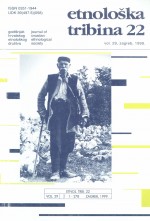Svatovski časnici
Wedding Honor Members
Author(s): Ines LasićContributor(s): Snježana Ivanović (Translator)
Subject(s): Customs / Folklore, Cultural Anthropology / Ethnology, Family and social welfare
Published by: Hrvatsko etnološko društvo
Keywords: wedding customs; wedding honor members; Lika;
Summary/Abstract: The author tries to provide a regional survey of wedding honor members in the area of Lika, and identify the relationship among particular wedding honor members, as well as overlapping or alteration of their roles. The article deals with characteristic wedding honor members, their names, selection and roles in the wedding customs of Lika: best man, chief attendant and other wedding honor members in related role of wedding honor attendant, groom’s man, bride’s companions and the wedding guest in charge of amusement. Specific wedding characters in the area of Lika are particularly considered, as well as some rarely represented wedding honors, and appearance of wolfs and masked characters at the wedding. The analysis of the available data has shown that it is not so simple to make a distinction between the appearance of the best man and the chief attendant in the role of the wedding honor attendant in the area of Lika. The best man in the role of the wedding honor attendant prevails in the Lika Bunjevci area (which is opposite to the claim of Erdeljanović who assigns that role with Bunjevci from Primoije and Lika exclusively to the chief attendant) while the chief attendant is subordinate, sometimes even unknown, wedding honor member. Chief attendant in the role of the wedding honour attendant is also confirmed in the whole area of Lika, without any special narrow region in which he would prevail in that role. Croats and Serbs know him in that role, but it could be concluded that chief attendant in the role of wedding honor attendant more often appears with Serbs from Lika. Besides, the general importance of the role of the wedding honor attendant in Lika has been identified, because it often occurs that besides chief attendant another person is appointed who shares some tasks related to that role with him. Sometimes besides or instead of one or both of these honor members other wedding honor members with other names are sporadically appointed who fills the post of the chief attendant or some duties within the framework of that role. The author has also found out that in the area of Lika groom’s man has retained his primary role of the brides guard, but in some areas the best man has interfered in this role, so sometimes the two of them share that role. Only in some cases the best man has taken over that role from the grooms man (in Pazarišta). Also the roles of these two wedding honor members overlap in many of their duties. The analysis of the roles of the main wedding honor members, best man, chief attendant, and groom’s man shows that overlapping and alteration of their roles and duties in this area during history is the reflection of ethnic-cultural permeating, which sometimes are so interwoven that it is hard to determine when and how these processes have occurred. Yet, the strengthening of the role of the best man in the area of Lika could be credited to Bunjevci from Lika, since he (the best man), in their areas of Lika almost as a rule has the role of the wedding honor attendant, at the same time taking over some duties from the groom's man. Synthesized review of the roles of wedding honor members and appearances of specific wedding characters point out to their great diversity, as well as to the overlapping of some more important wedding honor members in Lika, especially in its southern parts, which is the reflection of the impact of the population settled down in 16th and 17th centuries on the formation of present ethnocultural picture in some parts of Lika.
Journal: Etnološka tribina : Godišnjak Hrvatskog etnološkog društva
- Issue Year: 29/1999
- Issue No: 22
- Page Range: 133-152
- Page Count: 20
- Language: Croatian

